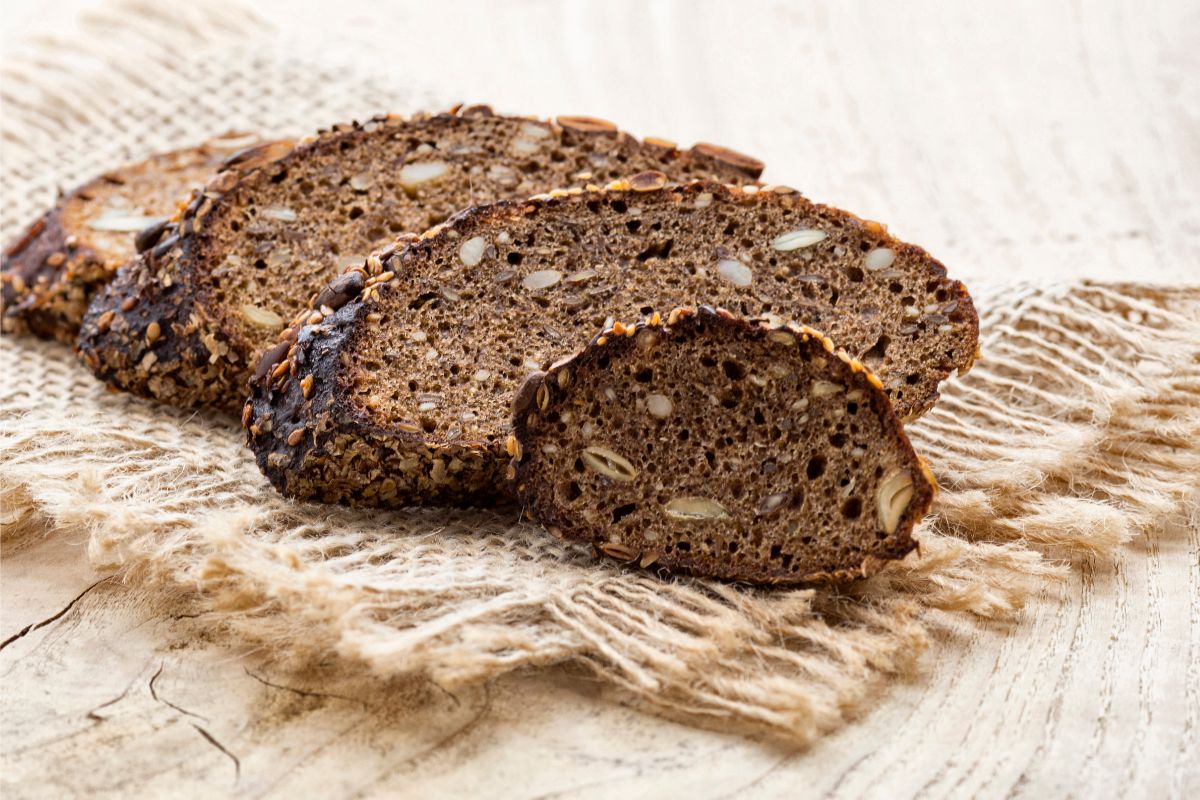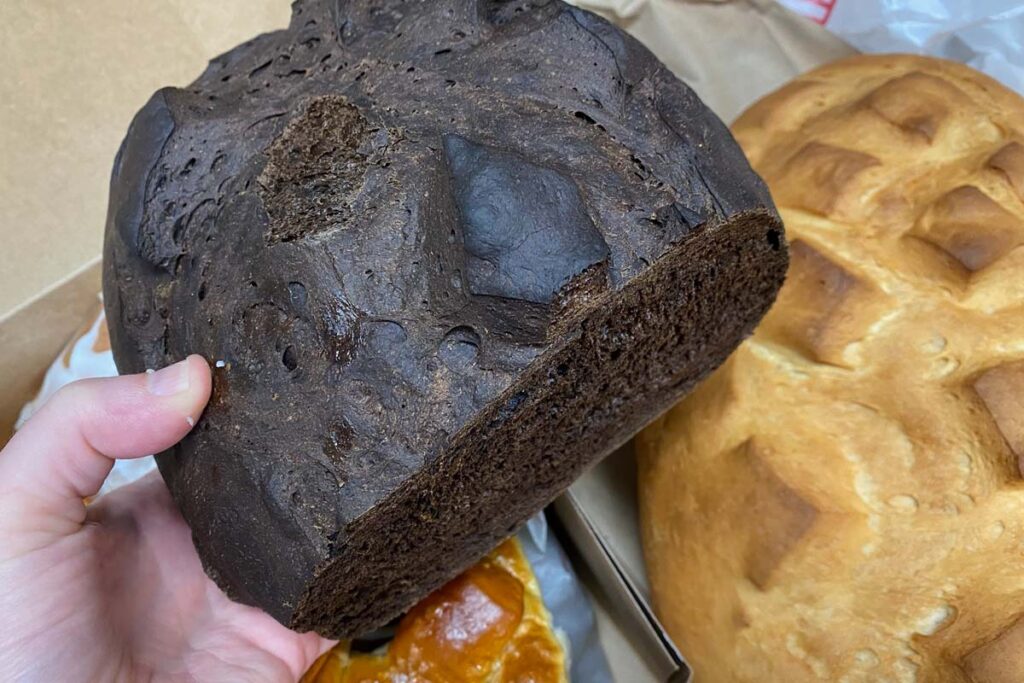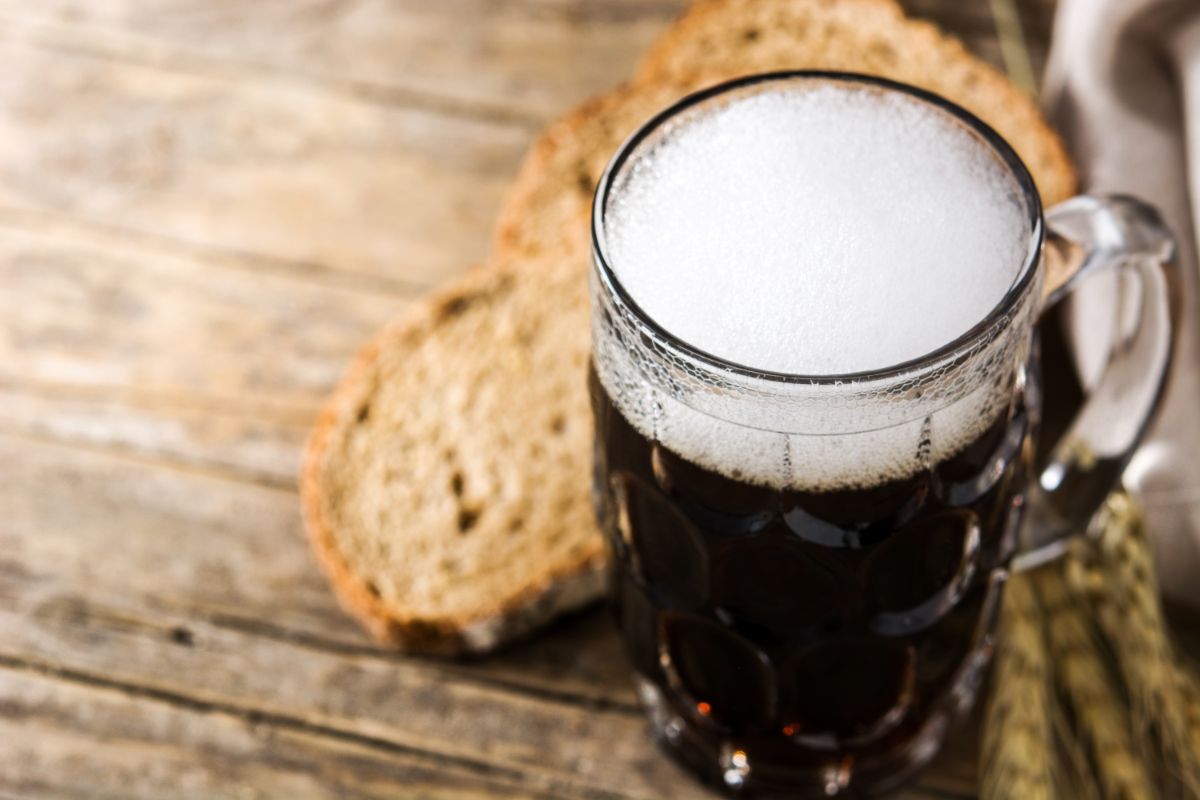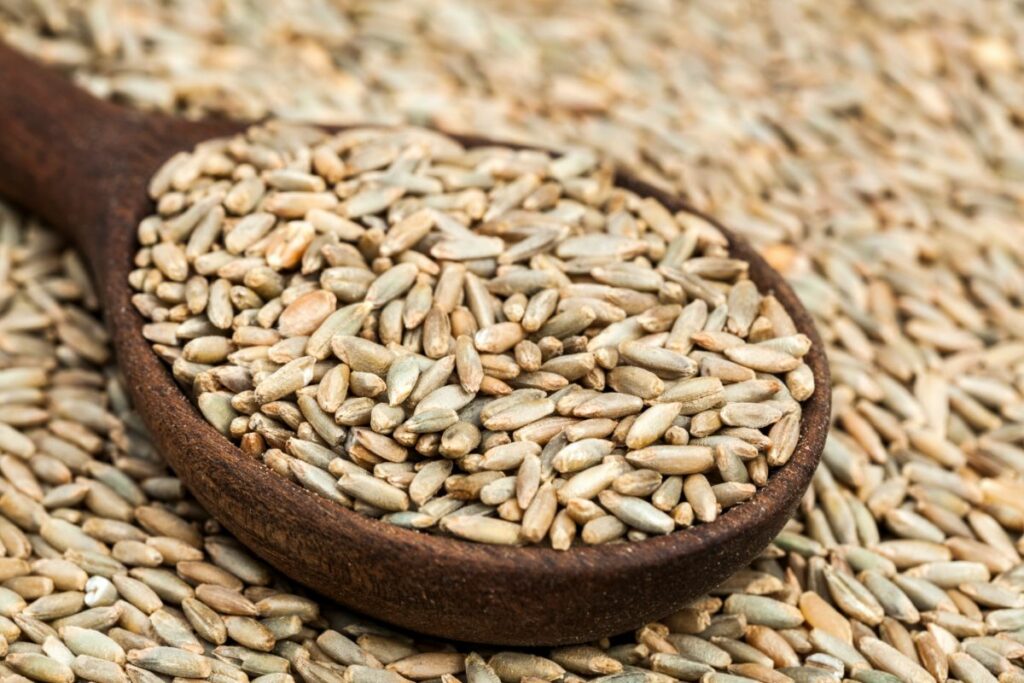If you love crackers, beer, or any darker bread at the grocery store, then you will have come across Rye in one way or another.
I was first introduced to rye bread as a child when I tried a Ruben sandwich my mom had ordered. The full-flavor rye bread (often called pumpernickel) paired with the tanginess of sauerkraut and thousand island dressing immediately made it my favorite.
So, what is Rye? Just like regular wheat, rye is a grain that has been used as a food for thousands of years. The rye plant, known as Secale cereale, is part of a family of cereal grains which comes from edible grasses. It is part of the same family as Wheat, Millet, Barley and Sorghum. You’ll typically find Rye at the grocery store in crackers and breads. It’s also used in the creation of many beers and whiskeys.
Rye can be grown almost anywhere around the world where it gets enough water and sunshine. It grows particularly well in northern temperate climates.
The majority of rye farmers plant rye seeds in the autumn, and then harvest in the spring.
Types of rye
There is a large variety of rye that can be used for different purposes. Here are some of the most popular types of rye which are rye grains at different processing stages.
- Rye berries: The whole rye kernel is called a “rye berry”. Similar to wheat, rye grows in large fields, and the kernel is surrounded by a hull which protects it from the weather. However, the hull is hard and indigestible, so it needs to be removed during the milling process.
- Cracked rye or rye chops: Cracked rye is similar to steel-cut oats or cracked wheat. This means that the rye berry (the whole rye kernel) is cut or cracked into different pieces. This makes the rye faster to cook, and it preserves its nutrients.
- Rye flakes: Rye flakes are similar to rolled oats. The rye kernels are steamed to soften them, and then rolled and dried. This process transforms rye berries into flakes which are ideal for porridge and baking. You can also use them as alternative to rolled oats.
Rye used in food

Rye is one of the oldest grain in the world, and it has been used almost since the early days when humans started farming.
Today, you can find rye in many different foods, and even drinks.
Rye flour
Rye flour is finely ground rye, similar to wheat flour. You can is it almost anywhere in baking, from crisp bread and sandwich bread to pretzels.
Unfortunately, most modern rye flours available at the grocery store are blends of light, medium, or dark rye flour blended with a higher protein flour, like wheat, for better rising. You can be inadvertently eating more conventional flour in a store-bought “rye flour” without knowing it.
In fact, there are no U.S. government-standards for what the term “rye flour” actually means. Unfortunately most commercial mills will remove the bran and germ to make the flour more palatable to bakers as well as increase its shelf life, but it means that you’re making it closer and closer to standard white bread.
Once ground, rye flour deteriorates in just 5-6 weeks. This is why store bought rye bread is only partially whole grain and why it’s important for you to make your own rye flour.
Try to buy stone-ground rye flour from an independent mill, as they’ll be able to let you know how much of the bran and germ have been removed (you want to keep all of it!). If you have to buy from the store, stick to a “dark” rye flour, as “light” rye flour has more starch and less protein than dark rye flour.
Learning how to make your own rye flour from 100% rye berries is a great way to ensure you’re getting all the health benefits of adding whole grains to your diet.
Rye bread

While rye isn’t suitable for a gluten-free diet, it contains relatively little gluten, compared to wheat. Many rye breads you purchase from bakeries are a combination of both Rye and wheat flour as wheat helps the loaf not be as dense.
Get to know common rye terminology to help understand that not all rye breads are created equally!
- Light bread: This variation is crafted using solely white rye flour, which is produced by grinding the endosperm of rye grain, which is what I call “all-purpose rye flour” or “white rye flour.” Rye grain endosperm is the grain’s starchy center
- Dark Bread: This is produced by grinding whole rye berries but it is often made by by coloring white rye flour with instant coffee, cocoa powder, or molasses
- Marbled bread: This variant is created by rolling together light and dark rye dough to create a marbled look
- Pumpernickel bread: This loaf is created using entire rye grains that have been roughly milled and similar to dark bread, can often contain cocoa powder, molasses, and coffee to give it its dark look

A lot of people will say they dislike rye bread, but what they are usually reacting to is the use of caraway seeds, which is common in rye breads. Removing the seeds can reduce the intensity of the flavors and rye bread’s natural, mild flavor can really shine.
Rye in sourdough starters
Rye flour plays a significant role in sourdough starters and is a popular choice if you’ve ever tried making a sourdough starter from scratch, or you need to save a dying starter you forgot about in your fridge.
Sourdough starters (which is what many American’s call fermented breads) aim is to cultivate a natural fermentation process that involves wild yeast and beneficial bacteria. Rye flour is often preferred over other types of flour for starting a sourdough culture because it makes the process much easier.
- Rye is rich in enzymes, vitamins, and minerals that provide essential nourishment to the microorganisms present in the starter. These nutrients promote the growth of wild yeast and lactobacilli, which are responsible for the fermentation process that imparts the distinct tangy flavor to sourdough bread
- Rye has a higher concentration of amylase enzymes compared to wheat flour. Amylase enzymes break down starches into fermentable sugars, providing a readily available food source for the yeast and bacteria in the starter. This enzymatic activity aids in the fermentation process and helps establish a vibrant and active sourdough culture
- Rye is also known for its higher content of pentosans, which are complex carbohydrates that enhance water absorption in the starter. This results in a wetter, more liquid-like consistency, which is favorable for the proliferation of beneficial microorganisms. The higher hydration level allows for a more active fermentation, leading to better acid development and a more pronounced sour taste in the final sourdough bread
If you’re beginning a sourdough starter, opt to use a mixture of rye flour and water initially, and you’ll help foster a faster and more reliable fermentation process during the critical early stages. Once the starter is established and shows signs of regular activity, you can then transition to feeding the starter to whatever wheat you prefer.
Rye grain
You can also use the whole rye grain in your breakfast cereal, cereal bars, or other baked goods. It’s not as common but leaving the entire berry intact is another way to enjoy rye.
Rye whiskey
Rye whiskey is a little spicier than the traditional whiskey recipes, which are made from wheat, barley or corn.
In the U.S., rye whiskey is a specific type of whiskey which has been distilled with 51% rye, and the rest is made up with barley and corn.
U.S. law carefully regulates the name “rye whiskey.” Rye whiskey which has been aged for less than two years is called “straight rye whiskey.”
Rye beer

In rye beer, rye is used as an alternative to barley. The traditional “Roggenbier” brewed in Germany contains a minimum of 60% rye malt.
Most rye beers in the US vary, as they are mainly brewed by microbreweries and homebrewers. Some brewers push the hop content to the same level as an IPA, which then makes the beer into a so-called “Rye IPA.”
There are also other varieties of rye beers across the world, including the Finnish sahti which is made with rye, wild yeast and juniper berries.
What does rye taste like?
Most people consider rye to have a relatively intense flavor but again, most often they are referring to caraway seeds, which are called for in most rye bread recipes. Rye can be overpowering in taste, but removing extra flavors is worth exploring in case you secretly love rye, but just dislike the added caraway seeds!
But regardless, a good tip is to stay away from pairing light condiments, such as olive oil, with rye bread. Instead, try mustard (or just salted butter) and you’ll find a better balance of strong flavors.
Rye also add spiciness to beer and whiskey. However, brewers must be careful, as rye can be a dominant flavor and should be used sparingly.
Health benefits of rye
Rye contains a number of important nutrients that our body needs to function properly.
Rye is rich in iron, fiber, magnesium, zinc and phosphorous. It also contains a good amount of manganese and protein. Note that when we talk about the health benefits of rye, we’re talking about the entire rye berry, not the processed flours that we see on grocery store shelves.
Here’s a nutritional chart for raw, whole rye berries based on a standard serving size of 100 grams:
| Nutrient | Raw, Whole Rye Berries (100g) |
|---|---|
| Calories | 335 kcal |
| Carbohydrates | 69g |
| Protein | 10g |
| Dietary Fiber | 15g |
| Total Fat | 1.6g |
| – Saturated Fat | 0.2g |
| – Monounsaturated Fat | 0.2g |
| – Polyunsaturated Fat | 0.8g |
| Sodium | 2mg |
| Vitamins & Minerals | |
| – Iron | 2.7mg (15% DV) |
| – Magnesium | 121mg (30% DV) |
| – Phosphorus | 374mg (37% DV) |
| – Potassium | 510mg (15% DV) |
| – Zinc | 3.7mg (25% DV) |
| – Vitamin B6 | 0.3mg (15% DV) |
| – Folate | 29mcg (7% DV) |
Rye is a nutrient-rich grain that offers a variety of health benefits. Here are some of the notable health benefits of rye:
- Rich in dietary fiber: Rye is a good source of both soluble and insoluble fiber, which aids in digestion, helps prevent constipation, and promotes a feeling of fullness
- Heart health: The soluble fiber in rye, particularly beta-glucans, has been shown to reduce cholesterol levels, which can help lower the risk of heart disease
- Blood sugar control: Rye has a low glycemic index, meaning it causes a slower rise in blood sugar levels compared to many other grains. This can be beneficial for people with diabetes or those looking to maintain stable energy levels
- Weight management: The high fiber content in rye can help promote satiety, potentially leading to reduced calorie intake and aiding in weight management
- Rich in antioxidants: Rye contains various antioxidants, including lignans, ferulic acid, and phytic acid, which can help combat oxidative stress and reduce the risk of chronic diseases
- Supports gut health: The fiber in rye acts as a prebiotic, feeding beneficial gut bacteria. This can promote a healthy gut microbiome and support digestive health
- Mineral-rich: Rye is a good source of essential minerals like magnesium, phosphorus, zinc, and iron. These minerals play crucial roles in bone health, energy production, and immune function
- Reduces inflammation: Some studies suggest that consuming rye can help reduce markers of inflammation, which is linked to various chronic diseases
- May reduce the risk of certain cancers: The lignans in rye have been studied for their potential to reduce the risk of certain types of cancers, particularly hormone-related cancers like breast cancer
- Supports bone health: Rye is a source of minerals like phosphorus, magnesium, and calcium, which are essential for maintaining strong and healthy bones
While rye offers numerous health benefits, there are some potential downsides and considerations to keep in mind:
- Gluten content: Rye contains gluten, a protein that can cause digestive issues in individuals with celiac disease or gluten sensitivity. Consuming rye can trigger symptoms in these individuals, so they should avoid it
- Phytic acid: Like many grains, rye contains phytic acid, which can bind to minerals like iron, zinc, and calcium and reduce their absorption. However, methods like soaking, sprouting, or fermenting rye can help reduce its phytic acid content
- FODMAPs: Rye contains fermentable oligosaccharides, disaccharides, monosaccharides, and polyols (FODMAPs), which can cause digestive discomfort in some people, especially those with irritable bowel syndrome (IBS)
- Allergies: Some individuals may be allergic to rye. Symptoms of a rye allergy can include hives, difficulty breathing, and anaphylaxis. Anyone suspecting a rye allergy should consult with a healthcare professional
- Cross-contamination: Rye is often processed in facilities that handle other grains, leading to potential cross-contamination. This can be a concern for individuals with celiac disease or severe gluten sensitivities
- Ergot contamination: Rye crops are susceptible to contamination by a fungus called ergot. While rare, consumption of ergot-contaminated rye can lead to ergotism, a serious condition with symptoms like hallucinations, painful limb contractions, and gangrene. Modern agricultural practices have significantly reduced the risk of ergot contamination
- Acrylamide: When rye bread is baked at high temperatures, it can produce acrylamide, a potentially harmful compound. However, the actual health risks of acrylamide from food sources are still being researched
- Digestive discomfort: Due to its high fiber content, sudden increases in rye consumption can lead to digestive discomfort, including bloating, gas, and diarrhea, especially in individuals not used to high-fiber diets
Adding rye to your diet
Incorporating rye into your diet can be both delicious and beneficial. Here are some ways to include rye in your meals and snacks:
- Rye bread: One of the most common ways to consume rye is in the form of bread. Opt for whole grain rye bread for maximum health benefits
- Rye crackers: These are a crunchy snack option and can be paired with cheeses, hummus, or other dips
- Rye hot cereal: Similar to oatmeal, you can cook rye flakes or cracked rye to make a warm and filling breakfast porridge. Top with fruits, nuts, and a drizzle of honey
- Rye salads: Add cooked whole rye berries to salads for added texture and nutrition
- Rye soups and stews: Whole rye berries can be added to soups and stews, much like barley, for a hearty addition
- Rye pancakes: Use rye flour to make pancakes or waffles for a twist on the traditional recipe
- Rye muffins and baked goods: Substitute part of the regular flour with rye flour in muffins, cookies, and other baked goods
- Rye smoothies: Blend rye flakes into your morning smoothie for an extra dose of fiber
- Rye as a side dish: Cooked rye berries can be seasoned and served as a side dish, similar to rice or quinoa
- Rye pasta: Some specialty stores offer pasta made from rye flour. It’s a unique way to incorporate rye into your meals
- Rye granola: Mix rye flakes with oats, nuts, seeds, and dried fruits, then bake to make a rye-based granola
- Rye wraps: Use rye tortillas or wraps for sandwiches and burritos
- Rye Beverages: In some cultures, rye is used to make traditional beverages, like kvass.
- Rye in Meat Dishes: Ground rye can be used as a filler or binder in meatballs, meatloaf, or burgers.
Frequently asked questions
Is Rye a wheat or grain?
Rye is a grain, similar to wheat. Both rye and wheat belong to the cereal grass family, but they are distinct species. While they share some similarities, they also have unique nutritional profiles and flavors.
Is Rye the healthiest grain?
“Healthiest” can be subjective and depends on individual dietary needs and preferences. Rye is undoubtedly a nutritious grain, rich in dietary fiber, vitamins, and minerals. It offers several health benefits, including supporting heart health, aiding digestion, and promoting blood sugar control. However, other grains like quinoa, barley, and oats also have their unique health benefits. It’s best to include a variety of grains in your diet to get a broad spectrum of nutrients.
What is Rye good for?
Rye is beneficial for several reasons:
- It’s a rich source of dietary fiber, which aids in digestion and promotes a feeling of fullness.
- Rye has a low glycemic index, making it a good choice for blood sugar control.
- It contains essential minerals like magnesium, phosphorus, and zinc.
- Rye is also a source of antioxidants, which can help combat oxidative stress.
- Consuming rye can support heart health by reducing cholesterol levels.
Is Rye the same as wheat?
No, rye and wheat are not the same. While both are cereal grains and share some similarities, they are distinct species with different nutritional profiles, flavors, and culinary uses. Additionally, rye bread has a denser and darker texture compared to most wheat bread, and it often has a more robust flavor.








